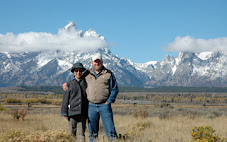First, I needed something to eat, so I headed to Old Town, which is one of the oldest cities in North America, being built in the 1700s. Today Old Town is a collection of souvenir shops, restaurants and these homemade-jewelry peddlers in and about the old buildings. Of the old towns I've been to (San Diego, Scottsdale, Fort Worth), this is probably the most interesting, with quite a few old buildings to stroll around. If you come here, don't forget to pay for your spot in the public parking lot or you'll get a $20 ticket.
I stopped in the Backstreet Grill for some steak tacos and rice. This was very good, but a bit pricey.
And a double-scoop at Steve's Ice Cream (butter pecan and cookie dough chocolate).
Then I headed to Petroglyph National Monument. This cactus is at the visitor center, which is the best place to start, because there are three or four petroglyph trailheads, and the rangers here can direct you to the one that fits your hiking/walking style and time available. And they'll remind you that gates are locked at 5 p.m. sharp.
I picked the trail that has the most petroglyphs-Piedras Marcadas Canyon-which has about a mile and a half of marked trail (and a bunch more trail that's not on the visitor center map, that I started to explore but turned back when I realized I was going perpendicular to the marked trail and thus farther into the "wilderness" rather than parallel). And this trail has no gate to lock at 5 p.m. The trailhead is from a little parking lot behind a Valvoline quick lube and strip mall. (Notice the Ford Expedition Avis gave me; it could fit eight people comfortably. I had selected a compact or midsize car.)
The trail heads off into desert wilderness, with houses to the left and the sound of cars somewhere off to the right.
The petroglyphs were carved about 700 or so years ago by predecessors to the Pueblo Native Americans.
I'm not sure what many of the pictures represent. This looks like a six-legged turtle or some insect with a tail.
I think this is a fat lizard.
These are either hands or turkeys. I think the holes in the pictures on the right are bullet holes from a large firearm.
This is the volcanic landscape where the pictures appear. If you look closely, the rocks in the middle of the photo on the left and those in the middle on the far right have petroglyphs.
It's hard to tell if some of these are meant to be serious or comical.
A few of the petroglyphs look like they were carved very recently. I wasn't sure how to tell.
Here's a hardy plant growing right out of the rock. I'm guessing that in the end, the plant will win.
Maybe a snake?
This is either a road-kill turtle or a lizard. I didn't see any traces of live turtles in the neighborhood, but I assume the ancient Native Americans ran into desert tortoises around here somewhere.
There definitely are lizards.
And bugs.
As I walked down the trail and climbed over volcanic boulders and tumbleweeds, I was thinking about rattlesnakes. Suddenly a pair of doves shot out of a sagebrush bush right next to me. I almost shot out of my skin. I didn't see any rattlesnakes, which is okay with me. I did see three jack rabbits all run up the volcanic hill at the same time. Then, as if they had practiced their moves, they all froze in place at the same time, each on a separate rock, and they stayed frozen until I moved, when they hopped up and over the hill.
My next stop was a place Paul recommended: Pappadeaux Seafood.
I had Atlantic Salmon Yvette, which was a 7-oz chargrilled salmon steak with shrimp, crayfish, and mushrooms in a white wine sauce with dirty rice (cajun style with spices and sausage). I thought I had died and gone to New Orleans. They also offered an 11-oz salmon steak, but I was painfully stuffed on 7 ounces and didn't finish half the rice; I can't imagine anyone finishing 11 ounces.
That's it for Albuquerque. Tomorrow I have meetings in the Albuquerque Convention Center from 7 a.m. until evening and then a flight out of here.
Wait. Here are a few more pics from show day.
Here's the trade show floor. The table down the right side has breakfast burritos, croissants, OJ and coffee. The idea is that people will talk to the vendors while they eat. This strategy actually works pretty well.
This is the Henry Schein "booth." These are very small shows, so our booth is just a six-foot table with a couple of signs, collateral, freebies like pens and buttons, and some sales people (three at this show).
Lunch at Pete's Frites near the University of New Mexico.
This area has some strange shops.
This is a board game "library" (cafe). You can order food and then for $3 per hour ($1 for kids and seniors) you can sit and play board games until you're bored or your wallet is empty.




























































